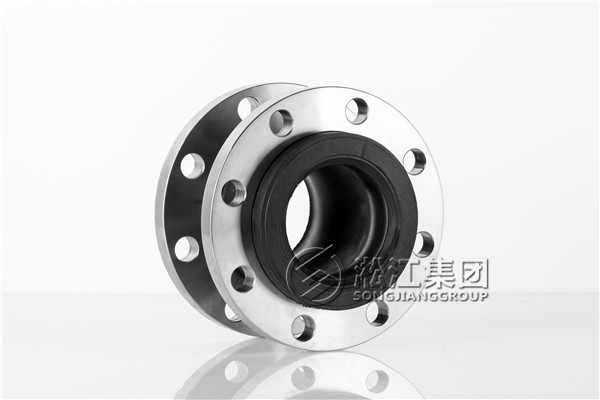Shanghai Songjiang Vibration Absorber Co., Ltd. provides Guangzhou Stanley Electrical with matching acid-alkali resistant flexible rubber expansion joints for the chemical industry. These joints are seamlessly integrated with an inner rubber layer, ensuring a smooth and seamless surface. Employing a vulcanization process, these chemical industry rubber expansion joints are designed to withstand high pressure, offer excellent elasticity, accommodate large displacements, balance pipeline deviations, absorb vibrations, reduce noise effectively, and facilitate easy installation.

Introduction to Chemical Industry Rubber Expansion Joints:
Rubber Material: EPDM Rubber
Flange Material: Stainless Steel Flange
Working Pressure: 16kg
Introduction to Ethylene Propylene Diene Monomer (EPDM) Rubber:
Ethylene Propylene Diene Monomer (EPDM) rubber is a terpolymer of ethylene, propylene, and a non-conjugated diene, commercially produced since 1963. Its main characteristic lies in its exceptional resistance to oxidation, ozone, and corrosion. EPDM rubber belongs to the polyene (PA66) polymer family and exhibits excellent vulcanization properties. Among all rubbers, EPDM has the lowest specific gravity. It can absorb a significant amount of fillers and oils without significantly affecting its properties, making it suitable for cost-effective rubber compound production.
Introduction to the Chemical Industry:
The chemical industry encompasses enterprises and units engaged in chemical industrial production and development. It permeates various aspects and is an indispensable and essential component of the national economy, with its development crucial for sustainable economic and social progress.
The chemical industry plays a significant role in the national economies of many countries, serving as a foundational and pillar industry. The growth rate and scale of the chemical industry directly impact various sectors of the socioeconomic sphere. The annual global production value of chemical products exceeds $1.5 trillion USD. Due to its diverse categories, complex processes, and wide range of products, the chemical industry is a major contributor to pollution. Chemical production involves the emission of various pollutants throughout the manufacturing, storage, use, and disposal stages, posing risks to the ecological environment and human health. The development of the chemical industry in a sustainable manner is of paramount importance for the economic and social development of humanity.
Introduction to Guangzhou Stanley Electrical:
Guangzhou Stanley Electrical Co., Ltd. is a joint venture established by Japan Stanley Electric Co., Ltd. (60%), Guangzhou Automobile Group Components Co., Ltd. (30%), and Honda R&D Co., Ltd. (China) (10%). Founded in 1920, Japan Stanley Electric Co., Ltd. is a multinational corporation and one of the world’s three largest automotive lighting manufacturers, as well as the largest optoelectronic device company in Japan. With over 65 production bases in 14 countries worldwide, including 37 production factories or research bases in Japan and 28 overseas production factories or bases, the company has a significant global presence. Guangzhou Automobile Group Components Co., Ltd. completed its transformation into a joint venture through shareholding reform in September 2005, becoming a Sino-foreign joint venture company. It has joint ventures and partnerships with various companies, including Tokyo Seating, Denso, Bridgestone, Toyota Boshoku, Hayashi Telempu, Stanley, Showa, Mitoyo, PACCAR, and Toyota Tsusho.
Guangzhou Stanley Electrical Co., Ltd. is located in the eastern section of the Guangzhou Economic and Technological Development Zone. Officially registered on September 29, 2002, with a registered capital of $44.7 million USD, the company’s main clients include Guangzhou Honda, Dongfeng Honda, Dongfeng Nissan, and GAC Mitsubishi Motors, among other well-known automakers. The company is primarily engaged in the research, development, and production of automotive lighting products, as well as the design, manufacture, and sale of automotive lighting molds and injection molds, providing aftersales services for its products.
The company commenced operation on May 21, 2003, with an initial investment to achieve an annual production capacity of 240,000 sets of automotive lighting. The second-phase project commenced construction at the end of 2004 and was completed and put into operation in June 2006, with a dust-free plant capable of producing 600,000 sets of automotive lighting annually. The third-phase dust-free plant was completed and put into operation in October 2011. Currently, the company’s annual production capacity has reached 1.3 million sets. Covering an area of approximately 100,000 square meters, the company has four major centers for management, marketing, production, and technology, with over 1,300 employees and an annual output value of approximately $2.4 billion USD.
Shanghai Songjiang Vibration Absorber Co., Ltd. provides Guangzhou Stanley Electrical with acid-alkali resistant flexible rubber joints tailored for the chemical industry. Seamlessly integrated with an inner rubber layer, these joints offer a smooth and seamless surface. Utilizing vulcanization technology, they are designed to withstand high pressure, provide excellent elasticity, accommodate large displacements, balance pipeline deviations, absorb vibrations, reduce noise effectively, and facilitate easy installation.
Related links:【EPDM】DN100 Single Sphere Stainless Steel Flanged Rubber Expansion Joint










